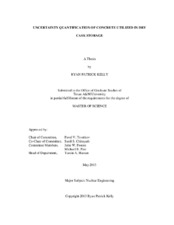| dc.description.abstract | The objective of this thesis is to quantify the uncertainty in radiation dose rate estimates outside of a used fuel dry cask storage unit due to the parametric variability of concrete composition and density. This requires the selection of a limited number of concrete compositions from a standardized database and the development of a reference dry cask model, which can be used to estimate dose rate from neutrons and gamma rays. The model was developed using the Monte Carlo N-Particle code, with reference data from a used fuel assembly source provided by operators at Comanche Peak Nuclear Power Plant and geometry based on the Holtec HI-STORM 100S used fuel dry cask storage system. The majority of the model was then fixed and the dose rates were compared when different concrete compositions at their nominal densities were substituted. Additional cases compared results for different concrete compositions at a fixed density, different densities for a fixed composition, and a different gamma energy source term for fixed compositions and densities.
The comparison of model results confirmed that the parametric variability of concrete composition is a major source of uncertainty for dry cask dose rates. While precise results depend on the compositions compared, general trends cam be identified. The majority of the dose in all cases, typically 70%, depended on gamma rays produced by the fission products. Density was the dominant factor in determining the dose rate, as expected. Composition variation while density was held fixed, however, indicated that the precise composition has a large effect on the dose rates produced by neutrons and gamma rays produced by neutron capture, on the order of 70% or higher for test cases, with only a moderate impact on the dose rate from gamma rays produced by other sources, on the order of 20% for test cases. Alterations to the gamma energy spectra produced by additional decay uniformly lowered the dose, and did not significantly change comparative concrete performance. Overall results indicate that, due to the lack of standardization of concrete poured on site, additional safety factors may be necessary due to variation of shielding effectiveness. | en |


